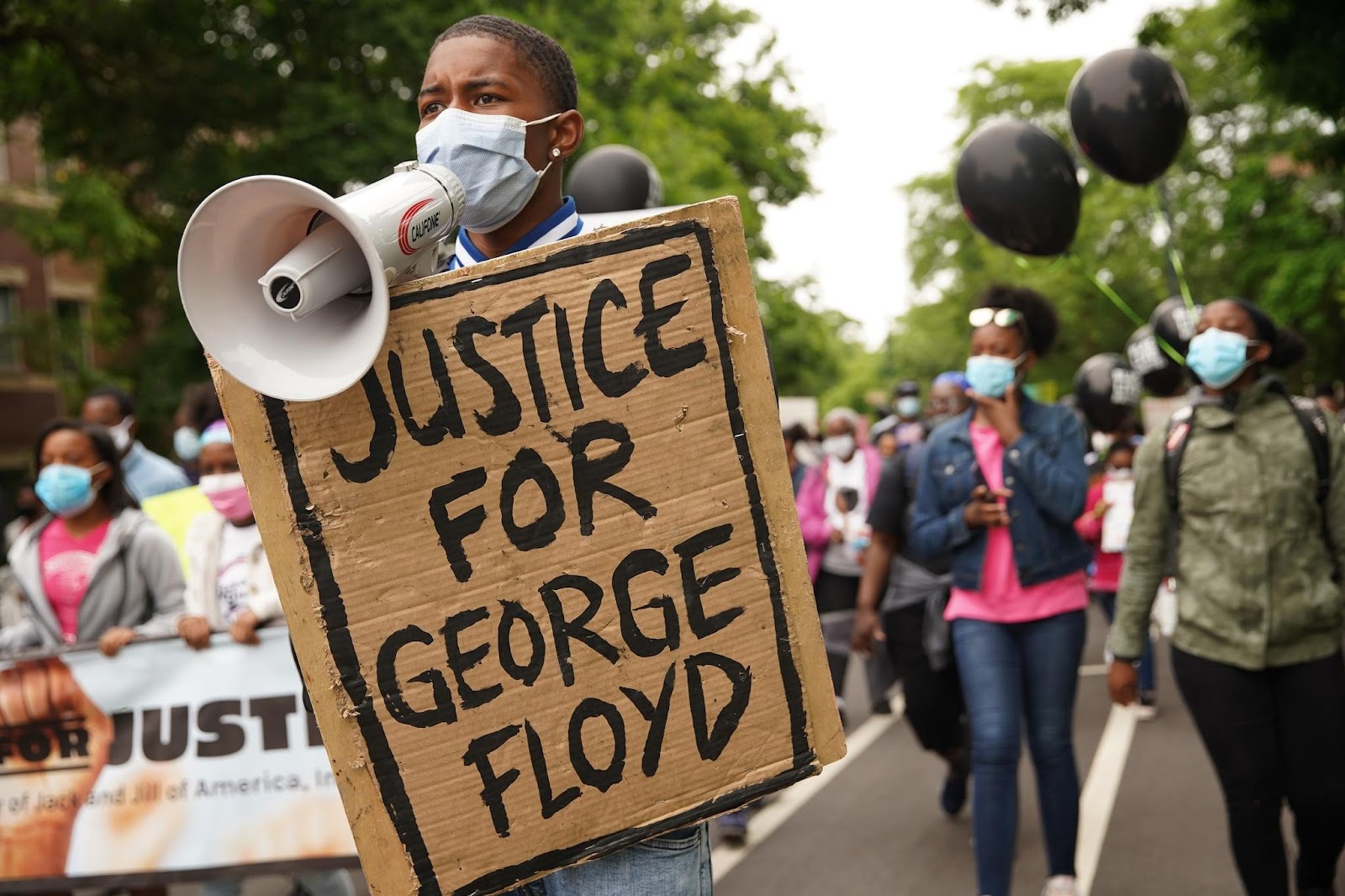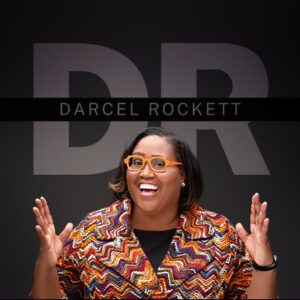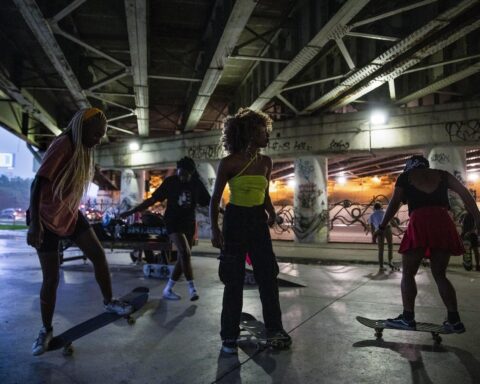For months the phrase “We’re all in this together” has been bandied about in response to COVID-19. Then the pandemic segued into protests against police brutality after the killing of George Floyd. Chicagoland residents of different races have been crossing neighborhood and ethnic lines in recent weeks to work together on activism, cleaning up and moving forward, and that’s in spite of Chicago’s segregationist history when it comes to housing, education and health inequities. We reached out to participants in different communities to see how they’re coming together during the protests.
“On a normal basis, we’re doing community education and art programming and connecting folks with resources, and then COVID struck and we pivoted. We’re in one of the ZIP codes that was heaviest affected or had the highest number of cases in 60632. We started doing pop-up food pantries in the neighborhood; we stepped up to fill in some of those spots and educate folks on getting access to PPE and testing.
“And then on top of that was the murder of George Floyd, which sparked an uprising across the nation, which we’re happy to support and be a part of. Some folks panicked and reverted to anti-black sentiment, which is deeply rooted amongst many cultures across the United States, and Latinx culture is not exempt from that.
“We reached out to folks to have conversations and post resources to educate folks on the black experience in the United States and anti-black sentiment within our own Latino communities. We wanted to make sure that as somebody that has some kind of voice and trust in the community, that we were doing our part to educate folks on how the black community is not the problem or enemy. It’s a problem of systemic racism and police brutality, and that is something that affects all of us. The black community takes the brunt of that and pays the most for that, but our community is also affected by that.”
GPLXC co-hosted a youth-led march promoting black and brown unity in Gage Park on June 6.
Santos called the rally beautiful. Members from organizations like Chicago Freedom School, GoodKids MadCity and the Let Us Breathe Collective spoke to those gathered, he said.
“We wanted to take to the streets to reclaim the narrative that our streets are for everybody and that we are here in support of Black Lives Matter and in support of an end to police brutality and defunding of police. I think what’s happening now is the unlearning of anti-blackness and standing up against things that maybe a generation or two ago would slide; now we have the knowledge that those thoughts are rooted in colonialism and racism.
“We’re calling on our Latinx communities to educate each other and our friends and families and neighbors on the issues that the black community is facing because right now the black community and black organizers have enough work on their hands.
“In terms of organizing around everything that is happening right now, we’re taking it day by day and reaching out directly to the families that we serve to have these conversations, but we’re standing by and ready to assist in the fight for racial justice and defunding of police at the call of organizations that we align ourselves with and are hoping to align ourselves with.”
Nikko Washington, artist
The Pilsen resident (by way of Hyde Park) has made his mark in the art community with album covers, his 2019 solo show “53 ’til Infinity,” and June 6 with a mural of black and brown unity on the west wall of a viaduct in the 300 block of North Damen Avenue. He was one of seven artists who collaborated on the artwork that featured a portrait of Breonna Taylor next to an image of Benito Juarez, the 19th century Mexican president who worked to oust French colonial powers. The image included a black man and a Latino man with their fists together. It took them nearly two days to finish, but the work was whitewashed by someone the next day.
“When it comes to watching a black man get killed on national television being played over and over again, you’re reminded of the traumas of the past over and over again whether it’s Michael Brown or Trayvon Martin. There are many other names, and you keep getting reminded our system is broken and not working for us. That’s why the mural was so important because anti-blackness is a specific problem, and it’s not just between black and white people — it’s everywhere. The black diaspora is so big that it trickles into every community. I wanted to call it out.
“The whitewashing of the mural was wild. At first I was angry, but then I understood what we were doing was really powerful for someone to spend their time and their money to work to do that. When people try to suppress your voice, that’s how I know you might be saying something worthwhile and something that needs to be heard. That showed me that we need to keep going.”
Tubs, an artist from the Latinx community, brought Washington to the project.
“The connections that we built were more important than the mural itself. It wasn’t about my time that I put in there; it was about what we’re trying to promote. I think we can continue to do that. They didn’t take our abilities or our hands; they only whited out one wall. So we got to keep going.”
Washington said he’s already in talks to do other mural collaborations in three different areas in Chicago. A GoFundMe campaign is raising money to make that happen.
Anthony Moseley, Collaboraction Theatre Company artistic director
Moseley says Collaboraction has taken a social change approach to theater since its founding in 1997. But almost two years ago, Moseley created a group workshop called Becoming a White Ally — a space where white people can ask questions and have frank conversations about topics such as racism, white privilege/fragility and how to work as a co-conspirator to help dismantle systems of oppression. White-identifying people gather on Zoom to participate in the conversation. According to Moseley, he had 52 people on a 90-minute conference in the wake of George Floyd’s killing recently, when he hadn’t been able to get more than eight people in a room together to talk about these issues previously.
“This is something I’ve been doing for a little time now. Zoom makes it much more accessible for people. A month ago, a year ago, five years ago, when you talked about defunding police, talked about reparations, when you talked about Colin Kaepernick, the zeitgeist of our country and our city was not yet ready to imagine a world in which real systemic change is a possibility, and now it feels like it can happen. This is an affinity group where white people can ask questions and do the work of expanding their comprehension and communication around complicit bias, systemic racism and how to start to dismantle it. I open up with a 20- to 25-minute lesson, and then I open up a discussion among everybody, and then I give a homework assignment, and then we do some sharing at the end.
“As long as I think there is work to do with white people to help us be a part of the solution, to no longer be complicit, then I will do this as long as there is a hunger and desire for it. What I’ve learned is that the experience of unlearning and reprogramming yourself, in the beginning, it’s very difficult work. And the deeper you go in, the darker it goes until you reach a threshold, and you hit the bottom of your own white guilt and shame. And then you realize the only way to go is up.
“I think it’s important to know that you don’t have to be accredited to lead discussions about unlearning white supremacy. Because half of the battle is having some basic knowledge and comprehension of how systems of oppression work, but the other half is the practice of talking about it. And if nobody has any place to talk about it, then they won’t ever get to the bottom and start coming up — on the other side of the guilt and shame and actually be an asset of change.
“This is not about self-improvement. This is about improvement of our city and our humanity. And before you can do anything, you really have to look in the mirror.”
Yvonne Blake, president of Jack & Jill Chicago Chapter, and chapter member Alexis Hart McDowell
Two Jack & Jill Chicago chapter moms came up with the idea for the nonviolent kid protest against racism Saturday in Mandrake Park, which had families and children from toddlers to teens in attendance. Because many parents don’t feel safe taking their children with them to protests, McDowell created one specifically for them. Kids created signs and posted their work under the #JJChicago hashtag before, during and after the protest. Families were encouraged to protest in real life and virtually, McDowell said. It was when her 7-year-old daughter came to her asking, “Why do white people hate us so much?” that McDowell took action.
“She learned about George Floyd on TikTok. I’m a very protective mother, and I take my job very seriously. Who wants their 7-year-old to see a murderer on TV? I want to protect them and keep them in a bubble, but because of their race, I don’t have the privilege of doing that. They have to know, they already know. They’re not immune.
“This protest was planned, prepared and put together with the sole focus of children. I had been sitting with my spirit as so many parents and mothers have been since George Floyd and before that. This latest death was just the catalyst for us to say, ‘Are we really going to do 60 more years of this? We got to do something.’ Our kids need to know how to be activists; let’s do a protest.
“We put up a registration page, and we got 2,000 registrations in three days. As soon as we shut down registration, we got inundated with emails saying, ‘I want to come. I’m still coming.’ We got overwhelming support from various communities — North Side, South Side, a very diverse crowd because parents were thirsty and very hungry for something like this for their children, to teach their children. As a parent, it’s very difficult to have to come out of a pandemic to go fight an epidemic that has been going on for generations.”
“It’s been multicultural, the response that we’ve gotten, and we’re happy about that,” Blake said. “We want our children to see that. We’re teaching them the power of action; we’re teaching them there are people who want to work with you and that we have to stand together for justice and equality. It’s better with more of us together, so we welcome everybody that wants to demonstrate peacefully.”
McKensie Mack, executive director of Affinity social justice organization, serving the black LGBTQ+ community
Affinity’s live monthly podcast “Living Room Chats” centers on conversations about political advocacy, culture and identity. Guests and commentors speak candidly about thoughts and experiences coinciding with a Facebook Live chat.
“There’s so much talk right now about defunding the police, racial equity, anti-racism and the ways in which we dismantle these centuries old systems of oppression. A lot of that work that we know about, we know because of the work of black women. That’s the power of black queer women, to take a structure that has been violent and that has perpetuated countless systemic inequities, tear it down, and build something new in its place that is rooted in healing, justice, and collective liberation.
“I think none of us can be free unless all of us are. You always have to start with yourself when it comes to healing. And then when it comes to other folks, non-black folks of color and white folks who want to do the work of dismantling systemic racism or developing an anti-racism analysis that is centered in pro-blackness, I think we have to recognize that we all have our own work to do. So just as we’re in a community right now as black queer folks, we’re in a community where we’re centering black queer women and we’re focused specifically on healing, all other communities have to be doing the same thing.
“Healing is going to look differently for folks on the South Side than the healing of somebody who is a white person doing work around dismantling systemic racism who lives in Edgewater. And that has to be OK. I think in order for us to sort of continue to engage in these cross-cultural dialogues, anti-racism has to come first.”
Essence-Jade Gatheright, Chicago Freedom School youth organizer, and Jacqulyn Hamilton, Freedom School director of wellness
Chicago Freedom School has been teaching movement building, civil rights history and social justice actions to young people ages 12-24 since 2007. The social justice boot camp deals with how racism, classism, gender bias and ableism present themselves in relationships and how to interrupt them and organize for change. The program is open to any young person wanting to make positive change in the community, according to Hamilton.
“A lot of our work is to remind and encourage young folks to be invested in themselves as valuable members of our communities, that they are necessary, Hamilton said. “Once you can start to think about yourself in that way, you can also get into the work of Black Lives Matter and into all kinds of liberatory movements that are out here. We do this work to make sure that we all know how valuable and how necessary we are able to be in any place and feel safe, happy, healthy whole — you have a right to that. And at any moment when a system, when a process or person tries to strip that from you, then you also have a right to defend yourself against that attack against your humanity. I am inspired by the resilience of our young folks who keep showing up for themselves and each other especially in this moment of health and political unrest.”
Gatheright, 16, has been a part of five protests already, maybe more. The Englewood resident joined Freedom School last summer, and now she’s being invited to speak at unity rallies. She says the education she’s received at Freedom School has definitely prepared her for the current climate of unrest.
“There are many people who have to make sacrifices for the sake of developing a movement. … This is a part of who I am and who I want to grow to be,” said the Lindblom student.







